Analyzing Institutionalization of Change in Organizations Report
VerifiedAdded on 2022/09/01
|9
|1855
|20
Report
AI Summary
This report delves into the critical concept of institutionalization of change within organizations, examining its various facets and implications. It begins by defining institutionalization and exploring how organizational characteristics influence its success. The report then outlines assessment methods to determine if institutionalization is evident, highlighting key outcomes and indicators. Furthermore, it identifies and describes three institutionalization processes that may indicate a lack of effective change implementation. The role of managers in fostering continuous change, learning, and improvement is discussed, with examples and references to relevant readings. Finally, the report concludes by describing future trends that are likely to impact managers and the process of institutionalization in the ever-evolving business landscape. The report emphasizes the significance of cultural aspects, diversity measures, and the need for managers to be strong communicators and supporters of change, ultimately contributing to the organization's competitive advantage and sustainability.
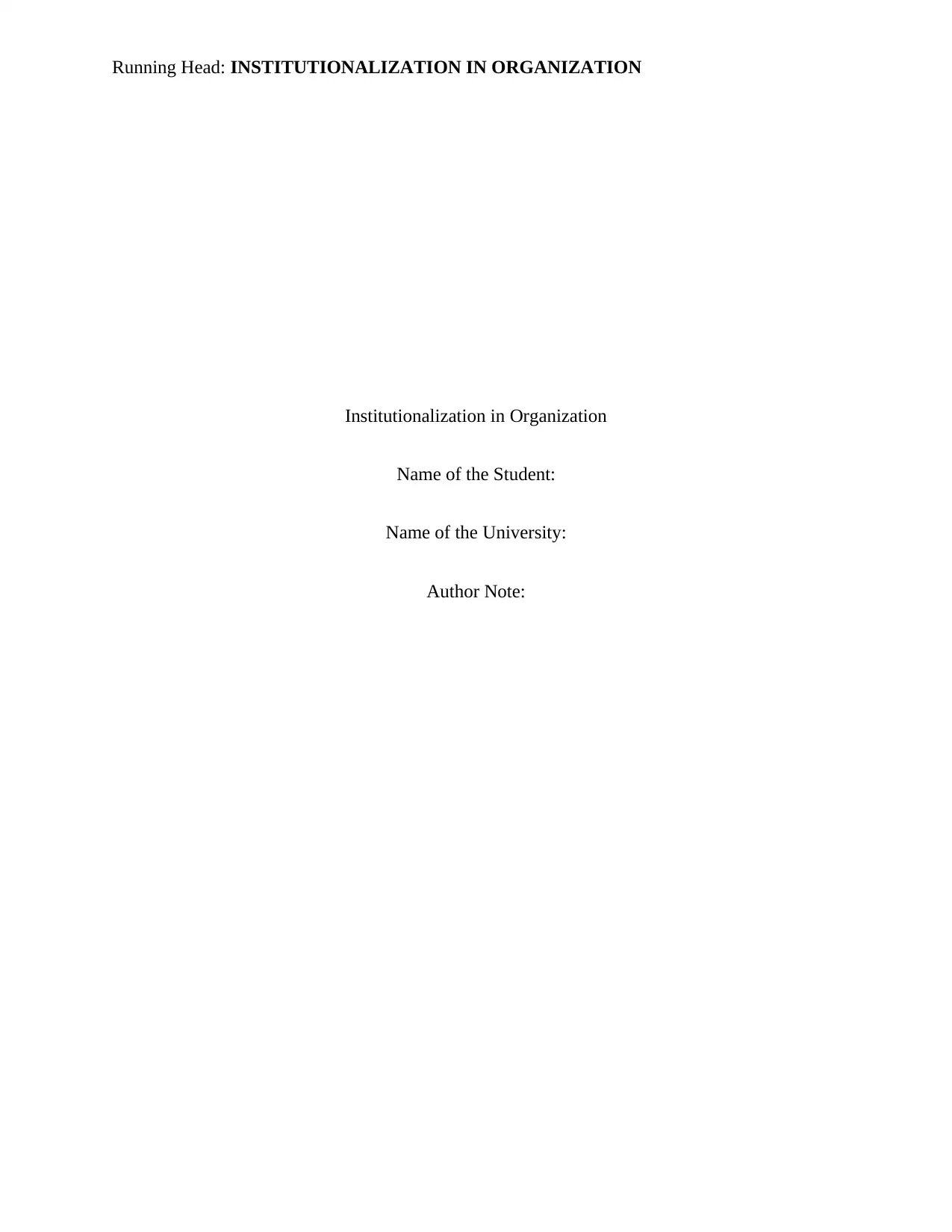
Running Head: INSTITUTIONALIZATION IN ORGANIZATION
Institutionalization in Organization
Name of the Student:
Name of the University:
Author Note:
Institutionalization in Organization
Name of the Student:
Name of the University:
Author Note:
Paraphrase This Document
Need a fresh take? Get an instant paraphrase of this document with our AI Paraphraser
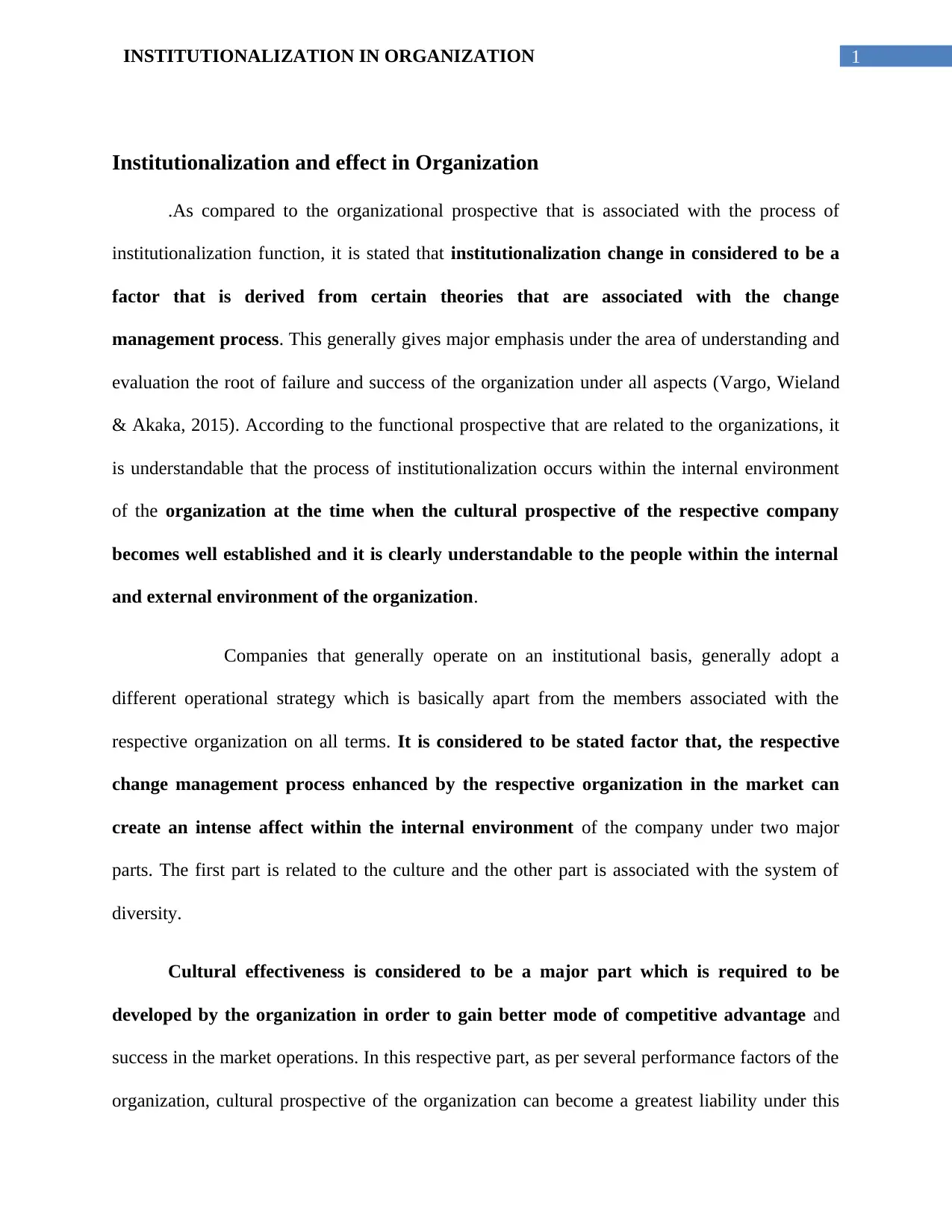
1INSTITUTIONALIZATION IN ORGANIZATION
Institutionalization and effect in Organization
.As compared to the organizational prospective that is associated with the process of
institutionalization function, it is stated that institutionalization change in considered to be a
factor that is derived from certain theories that are associated with the change
management process. This generally gives major emphasis under the area of understanding and
evaluation the root of failure and success of the organization under all aspects (Vargo, Wieland
& Akaka, 2015). According to the functional prospective that are related to the organizations, it
is understandable that the process of institutionalization occurs within the internal environment
of the organization at the time when the cultural prospective of the respective company
becomes well established and it is clearly understandable to the people within the internal
and external environment of the organization.
Companies that generally operate on an institutional basis, generally adopt a
different operational strategy which is basically apart from the members associated with the
respective organization on all terms. It is considered to be stated factor that, the respective
change management process enhanced by the respective organization in the market can
create an intense affect within the internal environment of the company under two major
parts. The first part is related to the culture and the other part is associated with the system of
diversity.
Cultural effectiveness is considered to be a major part which is required to be
developed by the organization in order to gain better mode of competitive advantage and
success in the market operations. In this respective part, as per several performance factors of the
organization, cultural prospective of the organization can become a greatest liability under this
Institutionalization and effect in Organization
.As compared to the organizational prospective that is associated with the process of
institutionalization function, it is stated that institutionalization change in considered to be a
factor that is derived from certain theories that are associated with the change
management process. This generally gives major emphasis under the area of understanding and
evaluation the root of failure and success of the organization under all aspects (Vargo, Wieland
& Akaka, 2015). According to the functional prospective that are related to the organizations, it
is understandable that the process of institutionalization occurs within the internal environment
of the organization at the time when the cultural prospective of the respective company
becomes well established and it is clearly understandable to the people within the internal
and external environment of the organization.
Companies that generally operate on an institutional basis, generally adopt a
different operational strategy which is basically apart from the members associated with the
respective organization on all terms. It is considered to be stated factor that, the respective
change management process enhanced by the respective organization in the market can
create an intense affect within the internal environment of the company under two major
parts. The first part is related to the culture and the other part is associated with the system of
diversity.
Cultural effectiveness is considered to be a major part which is required to be
developed by the organization in order to gain better mode of competitive advantage and
success in the market operations. In this respective part, as per several performance factors of the
organization, cultural prospective of the organization can become a greatest liability under this
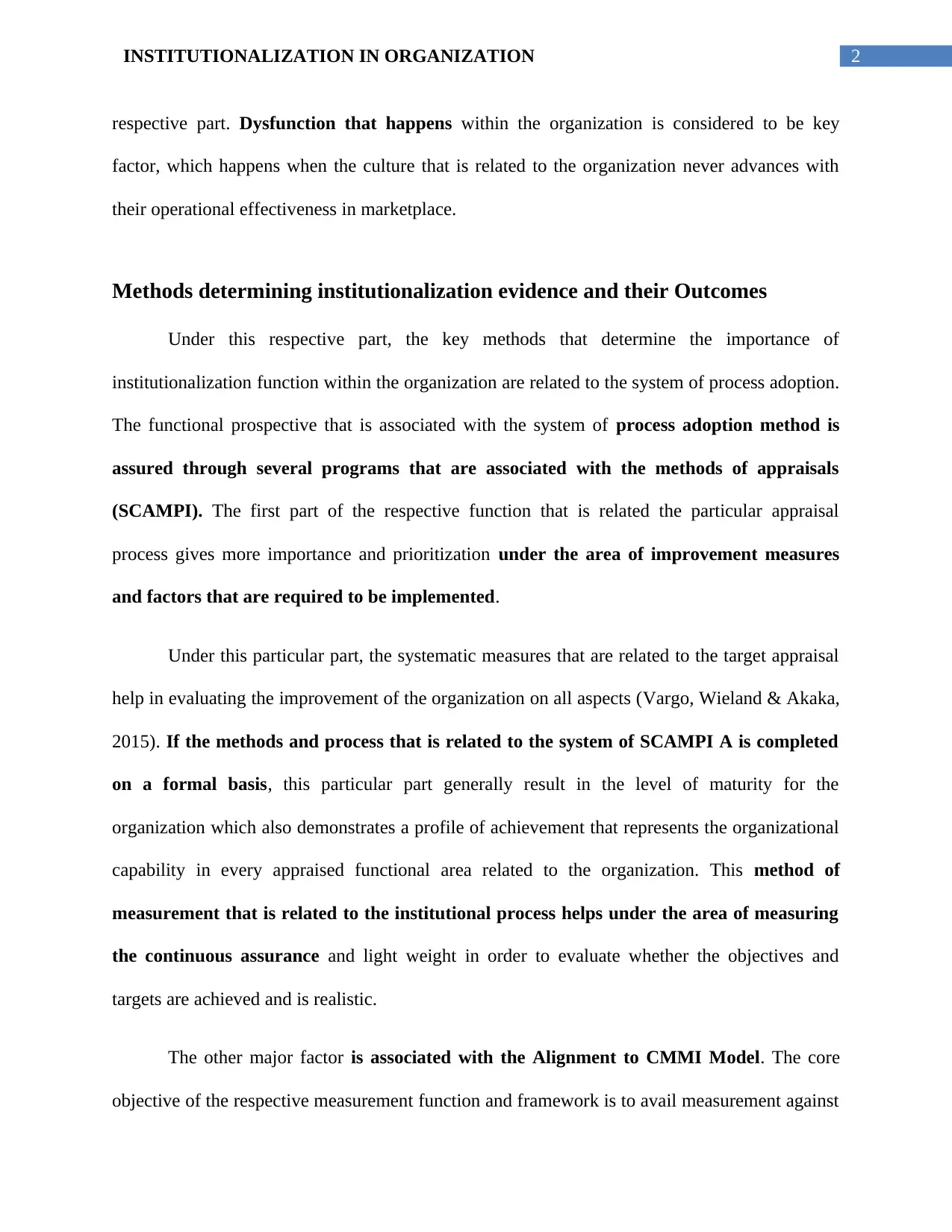
2INSTITUTIONALIZATION IN ORGANIZATION
respective part. Dysfunction that happens within the organization is considered to be key
factor, which happens when the culture that is related to the organization never advances with
their operational effectiveness in marketplace.
Methods determining institutionalization evidence and their Outcomes
Under this respective part, the key methods that determine the importance of
institutionalization function within the organization are related to the system of process adoption.
The functional prospective that is associated with the system of process adoption method is
assured through several programs that are associated with the methods of appraisals
(SCAMPI). The first part of the respective function that is related the particular appraisal
process gives more importance and prioritization under the area of improvement measures
and factors that are required to be implemented.
Under this particular part, the systematic measures that are related to the target appraisal
help in evaluating the improvement of the organization on all aspects (Vargo, Wieland & Akaka,
2015). If the methods and process that is related to the system of SCAMPI A is completed
on a formal basis, this particular part generally result in the level of maturity for the
organization which also demonstrates a profile of achievement that represents the organizational
capability in every appraised functional area related to the organization. This method of
measurement that is related to the institutional process helps under the area of measuring
the continuous assurance and light weight in order to evaluate whether the objectives and
targets are achieved and is realistic.
The other major factor is associated with the Alignment to CMMI Model. The core
objective of the respective measurement function and framework is to avail measurement against
respective part. Dysfunction that happens within the organization is considered to be key
factor, which happens when the culture that is related to the organization never advances with
their operational effectiveness in marketplace.
Methods determining institutionalization evidence and their Outcomes
Under this respective part, the key methods that determine the importance of
institutionalization function within the organization are related to the system of process adoption.
The functional prospective that is associated with the system of process adoption method is
assured through several programs that are associated with the methods of appraisals
(SCAMPI). The first part of the respective function that is related the particular appraisal
process gives more importance and prioritization under the area of improvement measures
and factors that are required to be implemented.
Under this particular part, the systematic measures that are related to the target appraisal
help in evaluating the improvement of the organization on all aspects (Vargo, Wieland & Akaka,
2015). If the methods and process that is related to the system of SCAMPI A is completed
on a formal basis, this particular part generally result in the level of maturity for the
organization which also demonstrates a profile of achievement that represents the organizational
capability in every appraised functional area related to the organization. This method of
measurement that is related to the institutional process helps under the area of measuring
the continuous assurance and light weight in order to evaluate whether the objectives and
targets are achieved and is realistic.
The other major factor is associated with the Alignment to CMMI Model. The core
objective of the respective measurement function and framework is to avail measurement against
⊘ This is a preview!⊘
Do you want full access?
Subscribe today to unlock all pages.

Trusted by 1+ million students worldwide
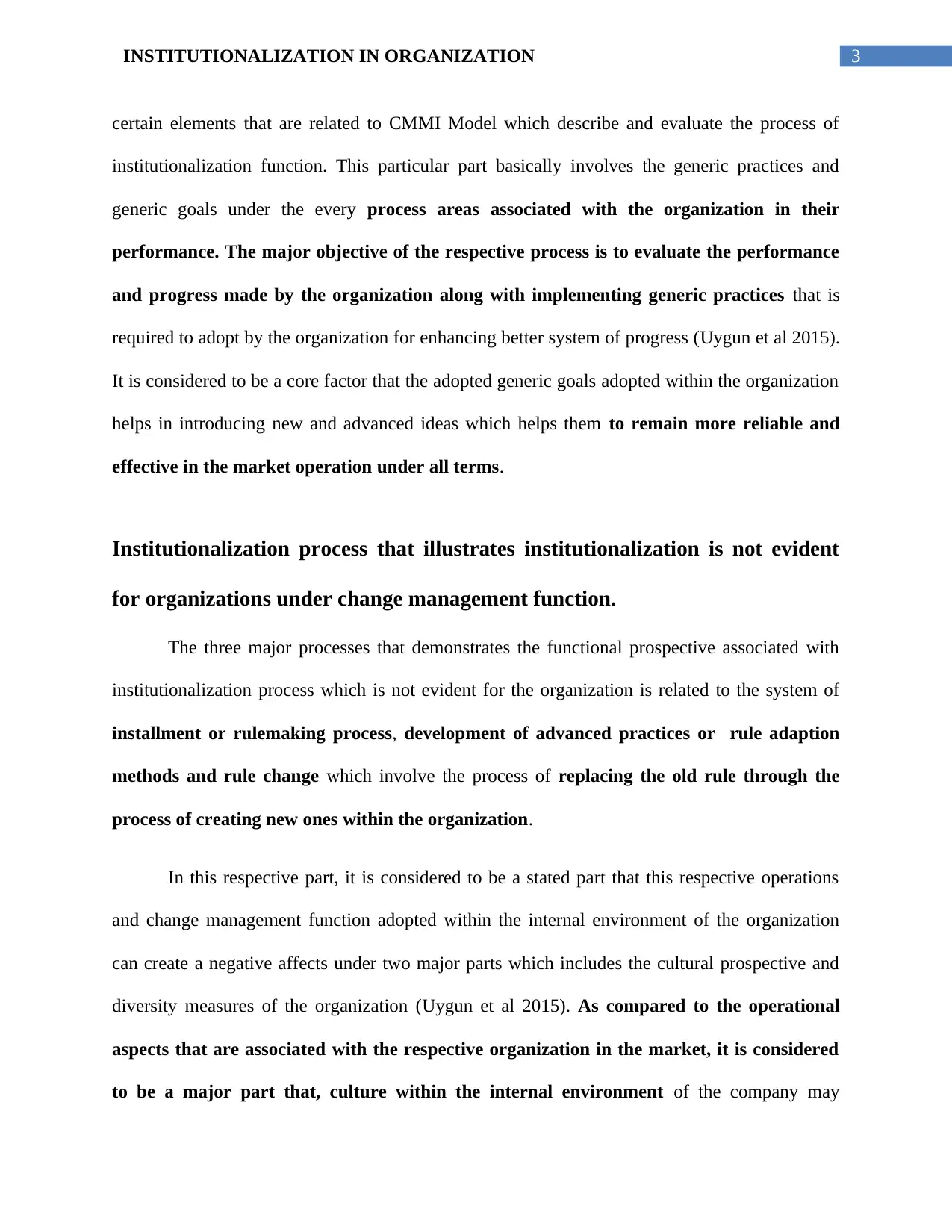
3INSTITUTIONALIZATION IN ORGANIZATION
certain elements that are related to CMMI Model which describe and evaluate the process of
institutionalization function. This particular part basically involves the generic practices and
generic goals under the every process areas associated with the organization in their
performance. The major objective of the respective process is to evaluate the performance
and progress made by the organization along with implementing generic practices that is
required to adopt by the organization for enhancing better system of progress (Uygun et al 2015).
It is considered to be a core factor that the adopted generic goals adopted within the organization
helps in introducing new and advanced ideas which helps them to remain more reliable and
effective in the market operation under all terms.
Institutionalization process that illustrates institutionalization is not evident
for organizations under change management function.
The three major processes that demonstrates the functional prospective associated with
institutionalization process which is not evident for the organization is related to the system of
installment or rulemaking process, development of advanced practices or rule adaption
methods and rule change which involve the process of replacing the old rule through the
process of creating new ones within the organization.
In this respective part, it is considered to be a stated part that this respective operations
and change management function adopted within the internal environment of the organization
can create a negative affects under two major parts which includes the cultural prospective and
diversity measures of the organization (Uygun et al 2015). As compared to the operational
aspects that are associated with the respective organization in the market, it is considered
to be a major part that, culture within the internal environment of the company may
certain elements that are related to CMMI Model which describe and evaluate the process of
institutionalization function. This particular part basically involves the generic practices and
generic goals under the every process areas associated with the organization in their
performance. The major objective of the respective process is to evaluate the performance
and progress made by the organization along with implementing generic practices that is
required to adopt by the organization for enhancing better system of progress (Uygun et al 2015).
It is considered to be a core factor that the adopted generic goals adopted within the organization
helps in introducing new and advanced ideas which helps them to remain more reliable and
effective in the market operation under all terms.
Institutionalization process that illustrates institutionalization is not evident
for organizations under change management function.
The three major processes that demonstrates the functional prospective associated with
institutionalization process which is not evident for the organization is related to the system of
installment or rulemaking process, development of advanced practices or rule adaption
methods and rule change which involve the process of replacing the old rule through the
process of creating new ones within the organization.
In this respective part, it is considered to be a stated part that this respective operations
and change management function adopted within the internal environment of the organization
can create a negative affects under two major parts which includes the cultural prospective and
diversity measures of the organization (Uygun et al 2015). As compared to the operational
aspects that are associated with the respective organization in the market, it is considered
to be a major part that, culture within the internal environment of the company may
Paraphrase This Document
Need a fresh take? Get an instant paraphrase of this document with our AI Paraphraser
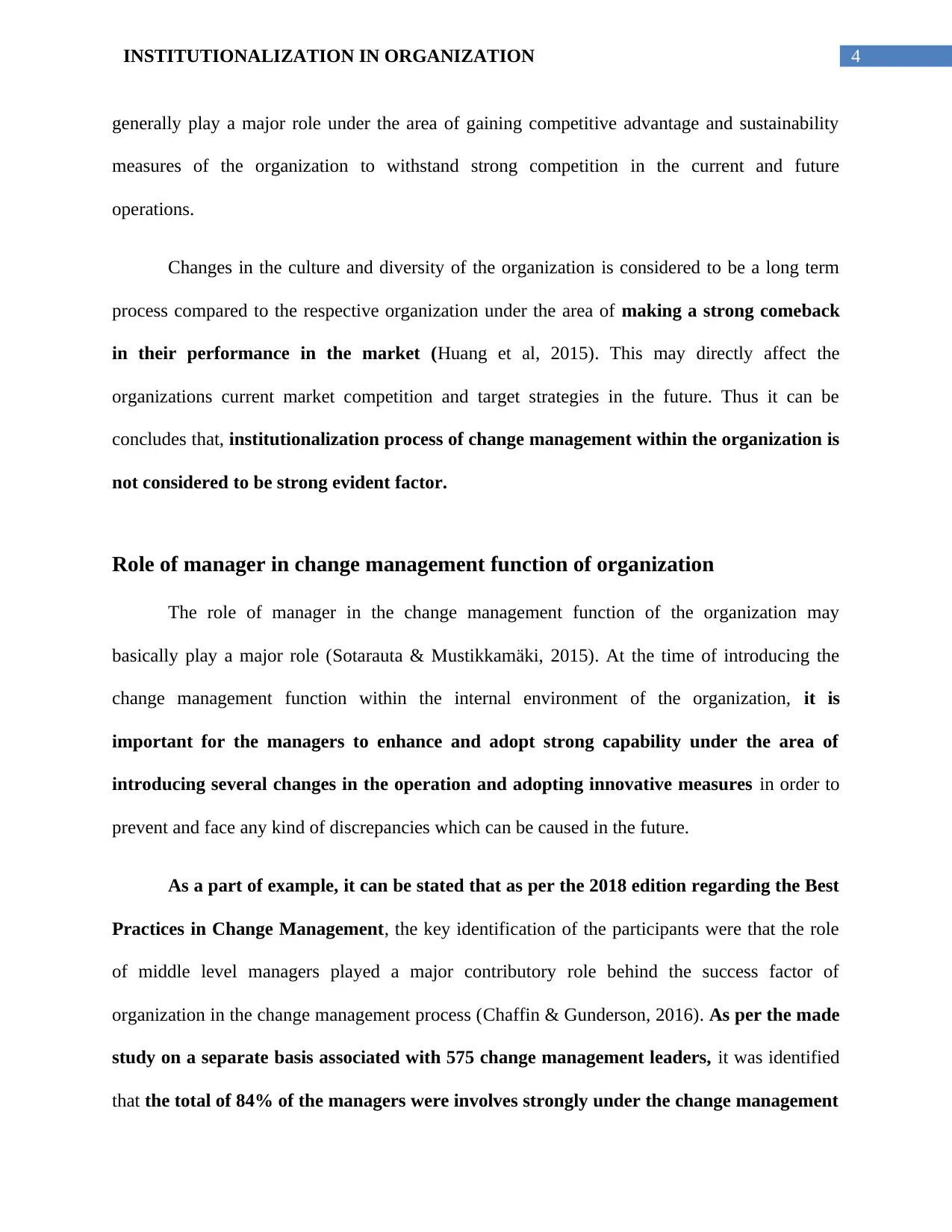
4INSTITUTIONALIZATION IN ORGANIZATION
generally play a major role under the area of gaining competitive advantage and sustainability
measures of the organization to withstand strong competition in the current and future
operations.
Changes in the culture and diversity of the organization is considered to be a long term
process compared to the respective organization under the area of making a strong comeback
in their performance in the market (Huang et al, 2015). This may directly affect the
organizations current market competition and target strategies in the future. Thus it can be
concludes that, institutionalization process of change management within the organization is
not considered to be strong evident factor.
Role of manager in change management function of organization
The role of manager in the change management function of the organization may
basically play a major role (Sotarauta & Mustikkamäki, 2015). At the time of introducing the
change management function within the internal environment of the organization, it is
important for the managers to enhance and adopt strong capability under the area of
introducing several changes in the operation and adopting innovative measures in order to
prevent and face any kind of discrepancies which can be caused in the future.
As a part of example, it can be stated that as per the 2018 edition regarding the Best
Practices in Change Management, the key identification of the participants were that the role
of middle level managers played a major contributory role behind the success factor of
organization in the change management process (Chaffin & Gunderson, 2016). As per the made
study on a separate basis associated with 575 change management leaders, it was identified
that the total of 84% of the managers were involves strongly under the change management
generally play a major role under the area of gaining competitive advantage and sustainability
measures of the organization to withstand strong competition in the current and future
operations.
Changes in the culture and diversity of the organization is considered to be a long term
process compared to the respective organization under the area of making a strong comeback
in their performance in the market (Huang et al, 2015). This may directly affect the
organizations current market competition and target strategies in the future. Thus it can be
concludes that, institutionalization process of change management within the organization is
not considered to be strong evident factor.
Role of manager in change management function of organization
The role of manager in the change management function of the organization may
basically play a major role (Sotarauta & Mustikkamäki, 2015). At the time of introducing the
change management function within the internal environment of the organization, it is
important for the managers to enhance and adopt strong capability under the area of
introducing several changes in the operation and adopting innovative measures in order to
prevent and face any kind of discrepancies which can be caused in the future.
As a part of example, it can be stated that as per the 2018 edition regarding the Best
Practices in Change Management, the key identification of the participants were that the role
of middle level managers played a major contributory role behind the success factor of
organization in the change management process (Chaffin & Gunderson, 2016). As per the made
study on a separate basis associated with 575 change management leaders, it was identified
that the total of 84% of the managers were involves strongly under the change management
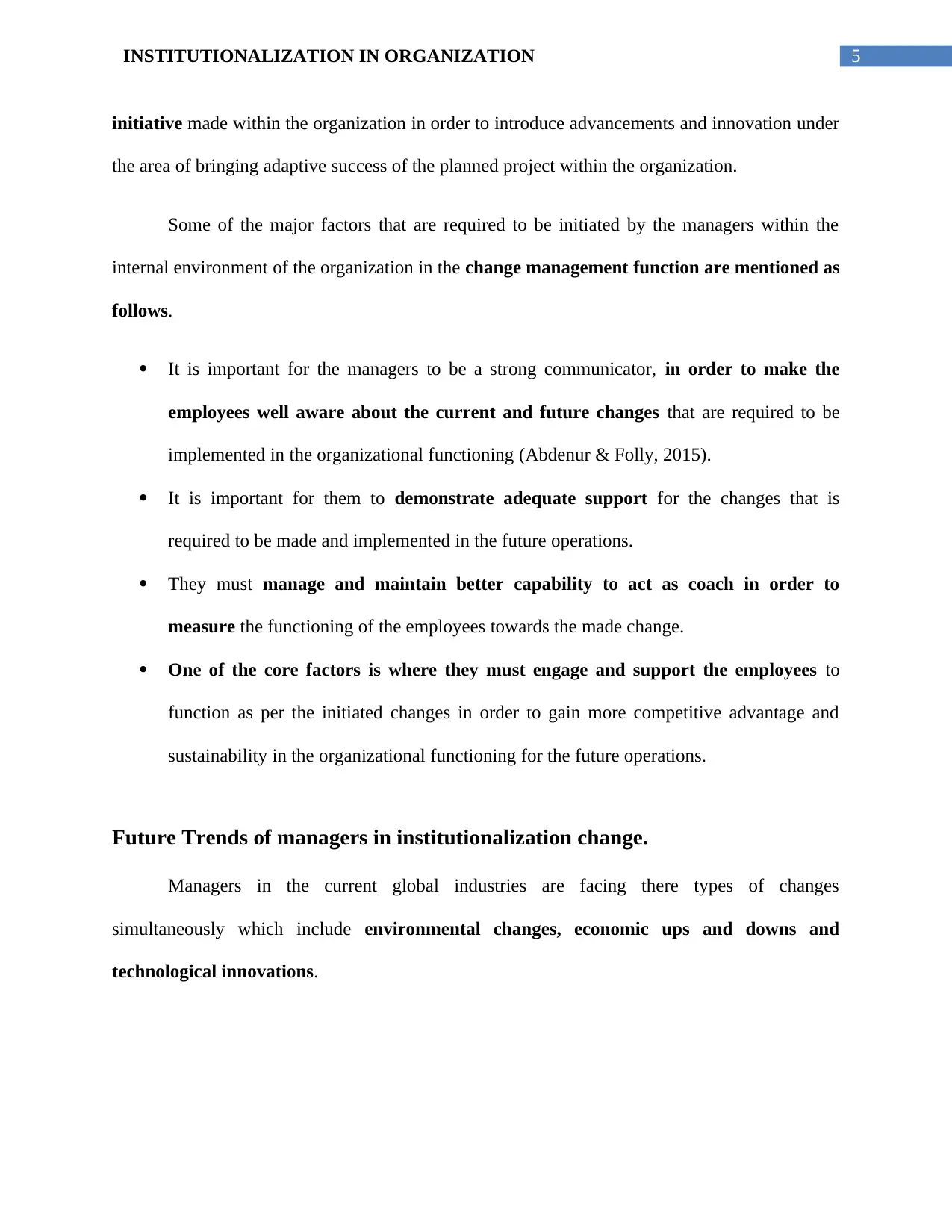
5INSTITUTIONALIZATION IN ORGANIZATION
initiative made within the organization in order to introduce advancements and innovation under
the area of bringing adaptive success of the planned project within the organization.
Some of the major factors that are required to be initiated by the managers within the
internal environment of the organization in the change management function are mentioned as
follows.
It is important for the managers to be a strong communicator, in order to make the
employees well aware about the current and future changes that are required to be
implemented in the organizational functioning (Abdenur & Folly, 2015).
It is important for them to demonstrate adequate support for the changes that is
required to be made and implemented in the future operations.
They must manage and maintain better capability to act as coach in order to
measure the functioning of the employees towards the made change.
One of the core factors is where they must engage and support the employees to
function as per the initiated changes in order to gain more competitive advantage and
sustainability in the organizational functioning for the future operations.
Future Trends of managers in institutionalization change.
Managers in the current global industries are facing there types of changes
simultaneously which include environmental changes, economic ups and downs and
technological innovations.
initiative made within the organization in order to introduce advancements and innovation under
the area of bringing adaptive success of the planned project within the organization.
Some of the major factors that are required to be initiated by the managers within the
internal environment of the organization in the change management function are mentioned as
follows.
It is important for the managers to be a strong communicator, in order to make the
employees well aware about the current and future changes that are required to be
implemented in the organizational functioning (Abdenur & Folly, 2015).
It is important for them to demonstrate adequate support for the changes that is
required to be made and implemented in the future operations.
They must manage and maintain better capability to act as coach in order to
measure the functioning of the employees towards the made change.
One of the core factors is where they must engage and support the employees to
function as per the initiated changes in order to gain more competitive advantage and
sustainability in the organizational functioning for the future operations.
Future Trends of managers in institutionalization change.
Managers in the current global industries are facing there types of changes
simultaneously which include environmental changes, economic ups and downs and
technological innovations.
⊘ This is a preview!⊘
Do you want full access?
Subscribe today to unlock all pages.

Trusted by 1+ million students worldwide
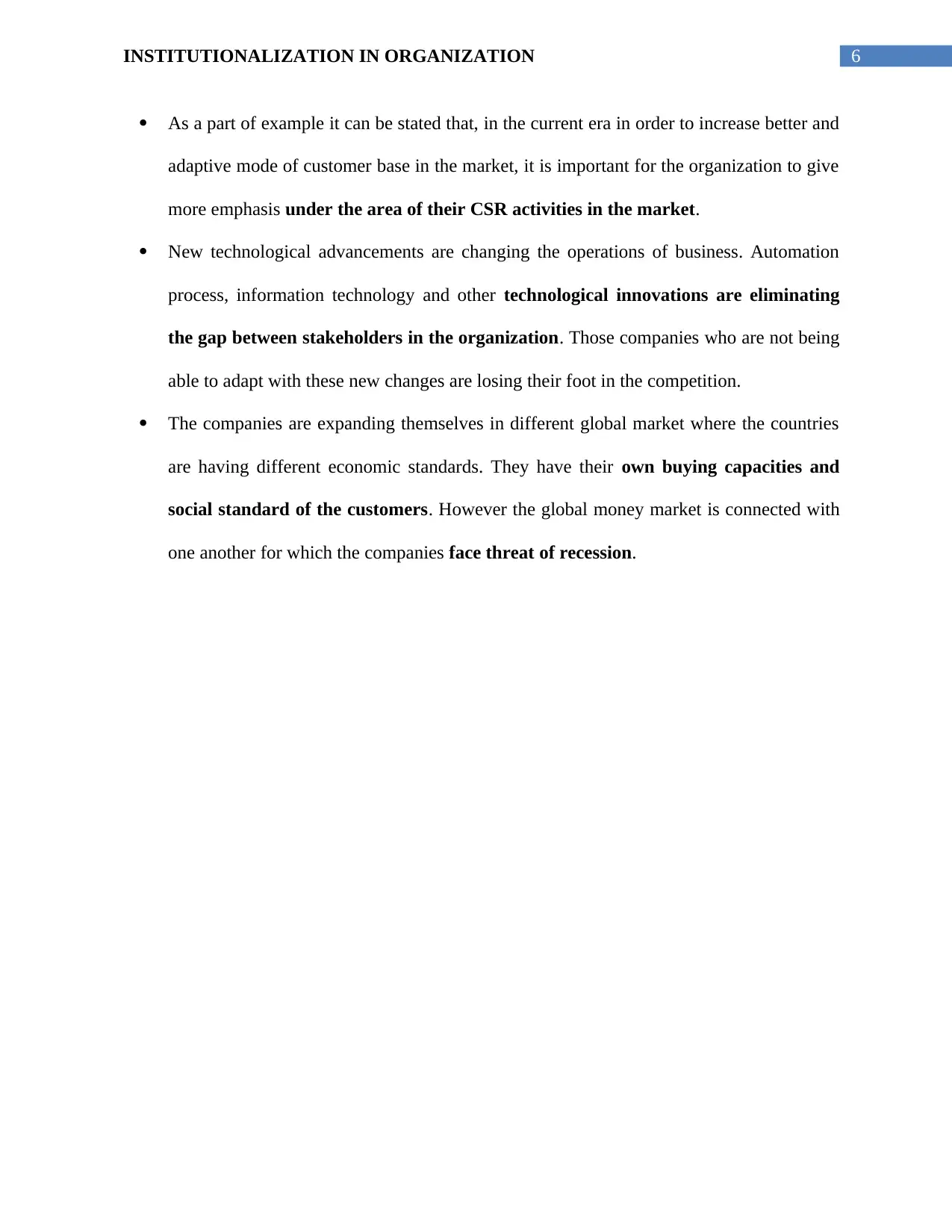
6INSTITUTIONALIZATION IN ORGANIZATION
As a part of example it can be stated that, in the current era in order to increase better and
adaptive mode of customer base in the market, it is important for the organization to give
more emphasis under the area of their CSR activities in the market.
New technological advancements are changing the operations of business. Automation
process, information technology and other technological innovations are eliminating
the gap between stakeholders in the organization. Those companies who are not being
able to adapt with these new changes are losing their foot in the competition.
The companies are expanding themselves in different global market where the countries
are having different economic standards. They have their own buying capacities and
social standard of the customers. However the global money market is connected with
one another for which the companies face threat of recession.
As a part of example it can be stated that, in the current era in order to increase better and
adaptive mode of customer base in the market, it is important for the organization to give
more emphasis under the area of their CSR activities in the market.
New technological advancements are changing the operations of business. Automation
process, information technology and other technological innovations are eliminating
the gap between stakeholders in the organization. Those companies who are not being
able to adapt with these new changes are losing their foot in the competition.
The companies are expanding themselves in different global market where the countries
are having different economic standards. They have their own buying capacities and
social standard of the customers. However the global money market is connected with
one another for which the companies face threat of recession.
Paraphrase This Document
Need a fresh take? Get an instant paraphrase of this document with our AI Paraphraser
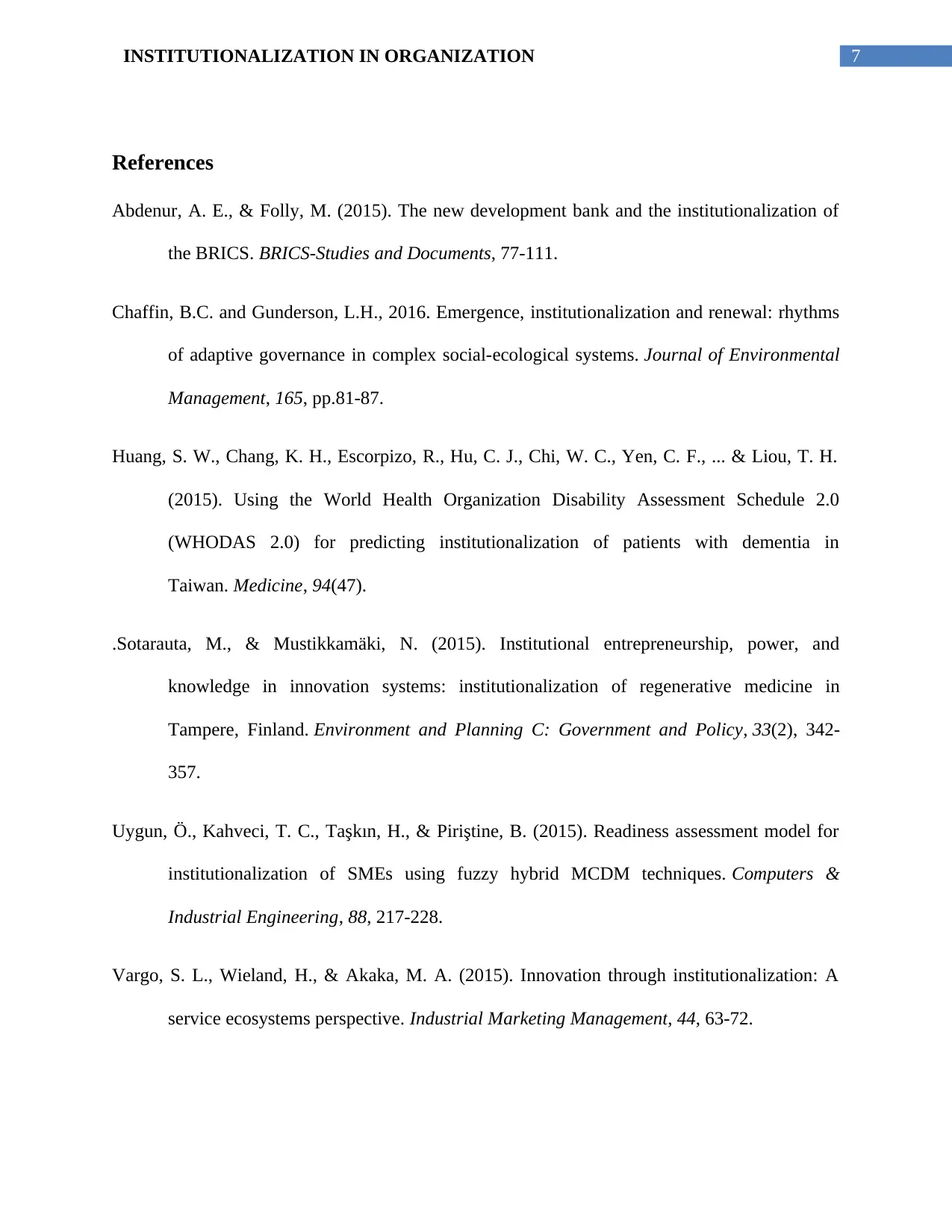
7INSTITUTIONALIZATION IN ORGANIZATION
References
Abdenur, A. E., & Folly, M. (2015). The new development bank and the institutionalization of
the BRICS. BRICS-Studies and Documents, 77-111.
Chaffin, B.C. and Gunderson, L.H., 2016. Emergence, institutionalization and renewal: rhythms
of adaptive governance in complex social-ecological systems. Journal of Environmental
Management, 165, pp.81-87.
Huang, S. W., Chang, K. H., Escorpizo, R., Hu, C. J., Chi, W. C., Yen, C. F., ... & Liou, T. H.
(2015). Using the World Health Organization Disability Assessment Schedule 2.0
(WHODAS 2.0) for predicting institutionalization of patients with dementia in
Taiwan. Medicine, 94(47).
.Sotarauta, M., & Mustikkamäki, N. (2015). Institutional entrepreneurship, power, and
knowledge in innovation systems: institutionalization of regenerative medicine in
Tampere, Finland. Environment and Planning C: Government and Policy, 33(2), 342-
357.
Uygun, Ö., Kahveci, T. C., Taşkın, H., & Piriştine, B. (2015). Readiness assessment model for
institutionalization of SMEs using fuzzy hybrid MCDM techniques. Computers &
Industrial Engineering, 88, 217-228.
Vargo, S. L., Wieland, H., & Akaka, M. A. (2015). Innovation through institutionalization: A
service ecosystems perspective. Industrial Marketing Management, 44, 63-72.
References
Abdenur, A. E., & Folly, M. (2015). The new development bank and the institutionalization of
the BRICS. BRICS-Studies and Documents, 77-111.
Chaffin, B.C. and Gunderson, L.H., 2016. Emergence, institutionalization and renewal: rhythms
of adaptive governance in complex social-ecological systems. Journal of Environmental
Management, 165, pp.81-87.
Huang, S. W., Chang, K. H., Escorpizo, R., Hu, C. J., Chi, W. C., Yen, C. F., ... & Liou, T. H.
(2015). Using the World Health Organization Disability Assessment Schedule 2.0
(WHODAS 2.0) for predicting institutionalization of patients with dementia in
Taiwan. Medicine, 94(47).
.Sotarauta, M., & Mustikkamäki, N. (2015). Institutional entrepreneurship, power, and
knowledge in innovation systems: institutionalization of regenerative medicine in
Tampere, Finland. Environment and Planning C: Government and Policy, 33(2), 342-
357.
Uygun, Ö., Kahveci, T. C., Taşkın, H., & Piriştine, B. (2015). Readiness assessment model for
institutionalization of SMEs using fuzzy hybrid MCDM techniques. Computers &
Industrial Engineering, 88, 217-228.
Vargo, S. L., Wieland, H., & Akaka, M. A. (2015). Innovation through institutionalization: A
service ecosystems perspective. Industrial Marketing Management, 44, 63-72.
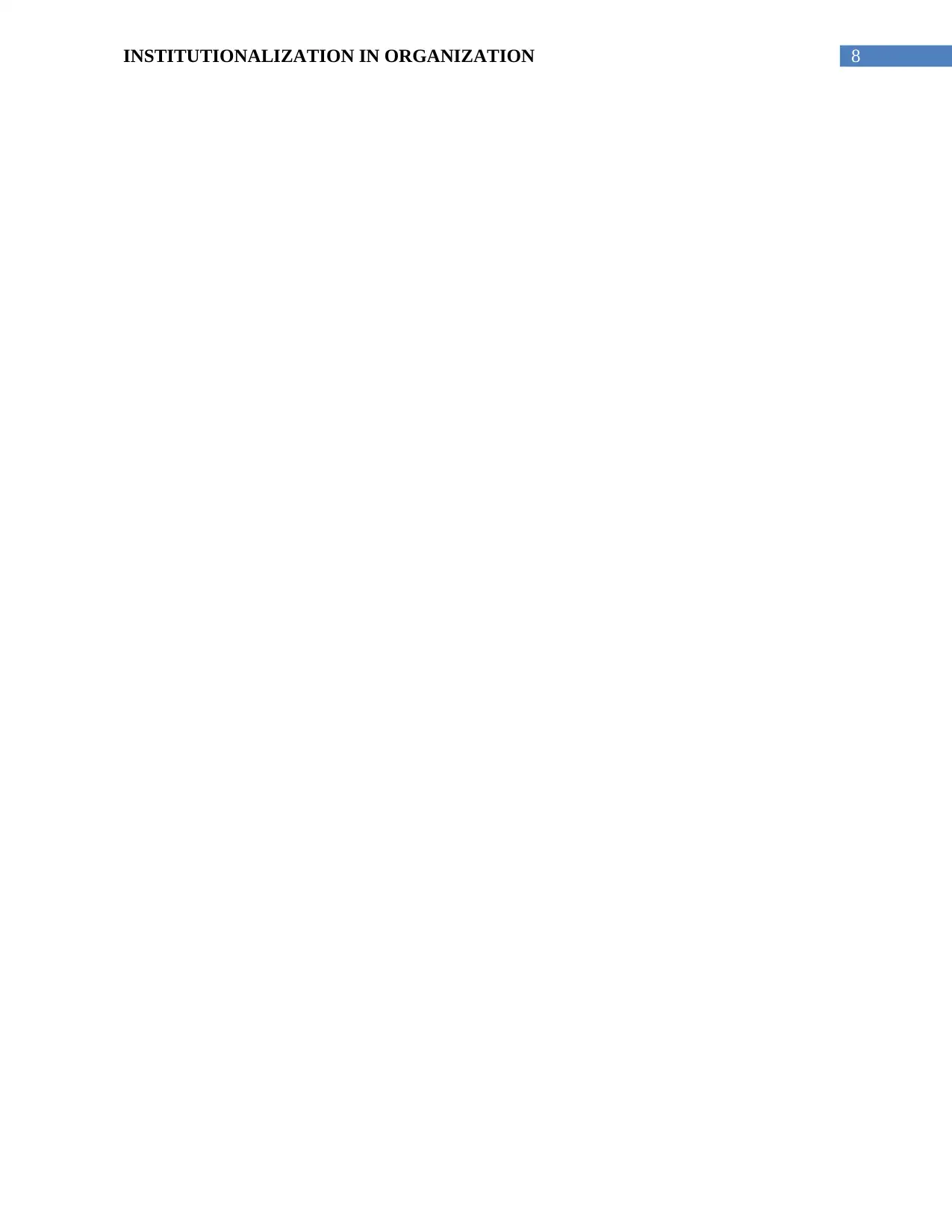
8INSTITUTIONALIZATION IN ORGANIZATION
⊘ This is a preview!⊘
Do you want full access?
Subscribe today to unlock all pages.

Trusted by 1+ million students worldwide
1 out of 9
Related Documents
Your All-in-One AI-Powered Toolkit for Academic Success.
+13062052269
info@desklib.com
Available 24*7 on WhatsApp / Email
![[object Object]](/_next/static/media/star-bottom.7253800d.svg)
Unlock your academic potential
Copyright © 2020–2025 A2Z Services. All Rights Reserved. Developed and managed by ZUCOL.





